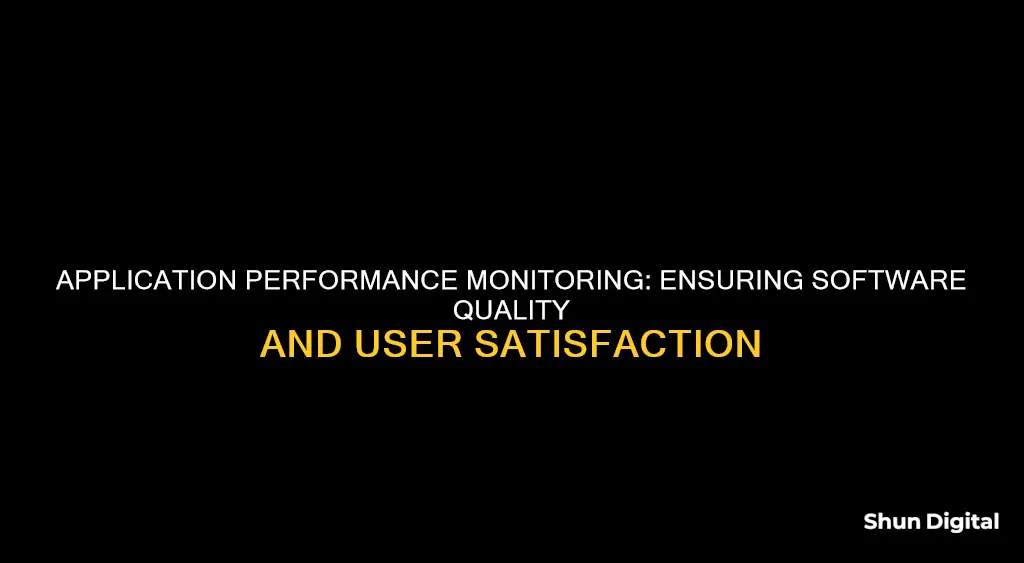
Application Performance Monitoring (APM) is the process of using software tools and telemetry data to monitor the performance of business-critical applications. APM is about monitoring an application's performance and ensuring that it meets the performance, reliability and valuable user experience required by employees, partners and customers. APM tools provide administrators with the data they need to quickly discover, isolate and solve problems that can negatively affect an application's performance.
| Characteristics | Values |
|---|---|
| Purpose | To ensure applications meet performance, reliability and user experience standards |
| Scope | Monitoring, managing and optimising software applications |
| Metrics | Response time, latency, resource usage, error rates, CPU usage, memory demands, disk read/write speeds, number of instances, request rates, uptime, application availability, garbage collection, user satisfaction |
| Benefits | Improved user experience, increased efficiency, reduced costs, enhanced collaboration, increased application stability and uptime, reduced incidents and shorter outages |
What You'll Learn

Monitoring software and telemetry data
Software telemetry automatically collects, measures, and transmits software usage and user data from a remote source to an IT system or central location for processing. This data is then analysed to monitor, control, and improve the remote systems. In the context of APM, telemetry data is collected from applications to gain insights into their performance and user behaviour.
Telemetry is a subset of monitoring, specifically pertaining to data collection from remote sources. It is a method used to monitor software progress remotely. When software developers create applications, they need to receive data to understand the functionality, performance, security, user experience, and potential improvements. Telemetry provides this data, allowing developers to make adjustments and improvements to applications quickly and efficiently.
The process of software telemetry involves six steps:
- Define the metrics that need to be tracked.
- Develop the instrumentation, including the necessary data points and lines of code.
- Transmit and store the data securely.
- Process the data, potentially using data mining techniques.
- Prepare the data for consumption through data visualisation and analysis.
- Take action on the insights, following through on the specified actions and gathering further data if needed.
Telemetry data can be transferred using analog or digital electronic devices, and it is often transferred wirelessly. However, it can also be transferred over other media such as telephone or computer networks, optical links, or wired communications.
In the context of APM, telemetry data is used to gain insights into application performance and user behaviour. This data can include measurements of startup and processing times, crashes, user behaviour, resource use, and system state. By collecting and analysing this data, developers can detect and diagnose complex application performance problems and ensure applications meet their expected level of service.
Monitoring Stroke Volume: Understanding Cardiac Output
You may want to see also

IT teams, DevOps and site reliability engineers
Application Performance Monitoring (APM) is a set of tools and processes that help IT teams, DevOps and site reliability engineers ensure that applications meet performance, reliability and user experience standards. APM is a critical aspect of a smooth-running business, helping to deliver flawless user experiences and ensuring digital services run smoothly with minimal downtime.
APM provides IT teams with real-time data and insights into application performance, allowing them to quickly troubleshoot issues. It helps identify where problems occur, highlights common issues in the digital customer journey, and determines whether changes are beneficial. For example, APM can be used to measure the success of a new customer service bot by tracking how many customers had their query solved by it.
APM also helps IT teams determine the optimal amount of resources, infrastructure and computing power needed to keep applications performing well, thus keeping operating costs down. It can be used in the development process to monitor and analyse synthetic traffic, uncover limitations and identify errors before an application goes live.
APM tools provide administrators with data to quickly discover, isolate and solve problems. They collect data on client CPU utilisation, memory demands, data throughput and bandwidth consumption. This data is then used to identify the root cause of a problem.
APM is an important practice for all enterprise companies, especially those with a web presence. It is a DevOps best practice and is essential for site reliability engineers to proactively monitor site reliability.
APM solutions provide deep visibility into the live performance of applications and the underlying infrastructure. They offer operational dashboards, real user monitoring, synthetic monitoring, serverless monitoring, database monitoring, mobile monitoring and infrastructure monitoring.
APM is a component of Application Performance Management (APM), which focuses on the broader concept of controlling an application's performance levels.
Asus Monitor Release Schedule: How Often Do They Launch?
You may want to see also

Customer satisfaction
Application Performance Monitoring (APM) is a critical tool for improving customer satisfaction. By tracking key software application performance metrics, businesses can ensure they maintain expected service levels and deliver a positive application experience for their customers.
APM provides valuable insights into the customer journey, allowing businesses to identify areas that deliver maximum value to end users. For example, if a business introduces a new customer service bot, APM metrics can measure how many customers successfully had their query solved by the bot. This enables businesses to make data-driven decisions and improve the overall customer experience.
Furthermore, APM helps to rapidly diagnose application performance issues, keeping downtime to a minimum. By minimizing disruptions, businesses can avoid frustrating their customers and maintain their brand reputation. With APM, technology teams can spend less time fixing existing applications and more time developing new ones, ultimately enhancing customer satisfaction.
APM also assists in optimizing resource utilization and right-sizing infrastructure. By gaining insights into application performance across the full stack, businesses can identify over-provisioned or underutilized resources, helping to reduce costs and improve efficiency. This, in turn, can lead to improved customer satisfaction as businesses can deliver a more reliable and high-performance experience.
In addition, APM enables businesses to monitor and analyze synthetic traffic, uncover limitations, and identify errors before an application goes live. By fixing bugs proactively, businesses can ensure a seamless experience for their customers, reducing the likelihood of negative feedback and increasing customer satisfaction.
Overall, APM is an invaluable tool for businesses to improve customer satisfaction by delivering reliable, efficient, and positive application experiences.
Is Your iPad Being Monitored? Here's How to Tell
You may want to see also

Reduced operating costs
Application performance monitoring (APM) is a collection of tools and processes that help IT teams ensure that applications meet performance, reliability, and user experience standards. APM tools provide data that helps IT professionals identify the root cause of a problem. This data includes client CPU utilization, memory demands, data throughput, and bandwidth consumption.
APM is an effective way to reduce operating costs. Here's how:
Optimizing Resource Allocation
APM tools help IT teams determine the optimal amount of resources, infrastructure, and computing power needed to keep applications performing at their best. By identifying over-provisioned and underutilized resources, organizations can right-size their infrastructure, avoiding unnecessary costs. APM data also helps in identifying when additional resources are required, preventing potential performance issues due to insufficient capacity.
Reducing Downtime
APM enables the rapid diagnosis of application performance issues, minimizing downtime. By quickly identifying and resolving problems, organizations can avoid financial losses associated with application unavailability.
Streamlining Development and Maintenance
APM tools can be integrated into the product development process, providing insights during the testing and pre-launch phases. This allows development teams to identify and fix bugs before an application goes live, reducing the time and resources spent on troubleshooting and maintenance after launch.
Enhancing Efficiency and Collaboration
APM promotes collaboration and efficiency across teams. By sharing metrics and analysis across business units, organizations can improve communication, break down silos, and increase employee engagement and productivity.
Informing Strategic Decisions
APM provides data-driven insights that inform strategic decisions. By understanding application performance, organizations can make informed choices regarding resource allocation, infrastructure adjustments, and application optimization, ultimately reducing operating costs.
Is Your Monitor Truly Off?
You may want to see also

Effective product development
Application performance monitoring (APM) is a critical component of effective product development. By utilising APM tools, development teams can gain valuable insights into application performance and user experience during the development process. This enables them to identify and address issues before releasing the product, resulting in improved product quality and user satisfaction.
APM provides a comprehensive understanding of application performance by monitoring various metrics such as CPU usage, memory demands, response times, error rates, and uptime. This data helps development teams optimise resource allocation, identify bottlenecks, and enhance overall performance.
Furthermore, APM facilitates collaboration and communication across different teams within an organisation. By sharing metrics and analysis, silos are broken down, improving efficiency and productivity. APM also assists in managing cloud resources and costs by identifying areas where resource utilisation and consumption can be optimised.
In addition, APM enhances application security by detecting software vulnerabilities and abnormal activities. With the increasing importance of AI-driven services, APM can also monitor the performance of embedded AI models, ensuring optimal data reliability and cost efficiency.
By incorporating APM into the product development process, organisations can deliver products that meet user expectations, perform reliably, and provide exceptional user experiences. This, in turn, contributes to the success and competitiveness of the business in today's fast-paced and complex digital landscape.
Connecting PS2 to a VGA Monitor: A Step-by-Step Guide
You may want to see also
Frequently asked questions
Application performance monitoring (APM) is the process of using software tools and telemetry data to monitor the performance of business-critical applications. APM helps businesses ensure that they maintain expected service levels and that customers receive a positive application experience.
APM offers several benefits to businesses, including improved customer satisfaction, reduced operating costs, effective product development, and enhanced business collaboration.
APM tools provide administrators with data to quickly discover, isolate, and solve problems that can negatively affect an application's performance. These tools monitor various aspects of an application, such as page loading times, response times, error rates, and resource utilization.
Common features of APM tools include operational dashboards, real user monitoring, synthetic monitoring, serverless monitoring, database monitoring, and infrastructure monitoring. These features provide insights into application performance and help identify and resolve issues.







